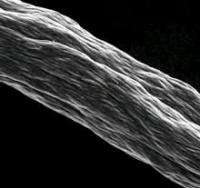November 10, 2009 weblog
Ultra-Long Carbon Nanotubes Could Serve as Future Transmission Lines
Lisa Zyga
contributing writer

(Â鶹ÒùÔºOrg.com) -- When it comes to carbon nanotubes, the majority of research so far has focused on small-scale applications. But now, a team of researchers from Rice University has created carbon nanotubes that are hundreds of meters long, yet just 50 micrometers thick. The researchers say there is no limit to how long the nanotubes can be made, which opens the doors to large-scale applications including using nanotubes as electrical transmission lines and as the basis of structural materials.
The Rice project began in 2001, led by the late Nobel laureate Richard Smalley. After years of research investigating solution-processing techniques, the scientists found that a superacid called chlorosulphonic acid could spontaneously dissolve carbon nanotubes at concentrations 1,000 times greater than any other solvent. The method can produce well-aligned carbon nanotubes on a large scale, in which nanotubes can be shot out of a nozzle similar to a shower head. The researchers have published the details of the acid-processing technique in a recent issue of Nature Nanotechnology.
Since carbon nanotubes are highly conductive, the researchers are currently working on a project for making electrical transmission lines. "Metallic nanotubes conduct electricity better than copper, they're lighter, and they fail less often," said Rice chemical engineering professor Matteo Pasquali.
To make transmission lines, the researchers will need extremely large amounts of metallic nanotubes. Currently, there aren't any good methods that can make large batches of nanotubes that contain all metallic nanotubes without any semiconducting nanotubes. But some recent research in this area has been promising, and the researchers predict that a breakthrough could occur in the near future.
More information: True solutions of single-walled carbon nanotubes for assembly into macroscopic materials, Nature Nanotechnology, Published online: 1 November 2009;
via:
© 2009 Â鶹ÒùÔºOrg.com
Written for you by our author —this article is the result of careful human work. We rely on readers like you to keep independent science journalism alive. If this reporting matters to you, please consider a (especially monthly). You'll get an ad-free account as a thank-you.

















